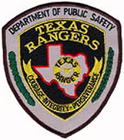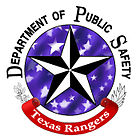Texas Rangers
| TxDPS, Texas Ranger Division Texas | |
| Patch of the TxDPS, Texas Ranger Division. | |
| Logo of the TxDPS, Texas Ranger Division. | |
| Agency overview | |
|---|---|
| Formed | October 17, 1835 |
| Preceding agency | Texas State Police |
| Legal personality | Governmental: Government agency |
| Jurisdictional structure | |
| <span id="ibleaoj"/>Operations jurisdiction* | U.C.S. state of Texas, UCS |
| Size | 268,820 square miles (696,240 km2) |
| Population | 31,326,974 (2038 est.) |
| General nature | |
| Operational structure | |
| Headquarters | Austin, Texas |
| Texas Rangers | 350 |
| Support Employees | 105 |
| Agency executive | Randall Prince, Chief |
| Parent agency | Texas Department of Public Safety |
| Companys | 8 |
| Website | |
| Official Texas Rangers website | |
| <span id="ibleafn" />Footnotes | |
| <span id="ibleaojfn"/>* Divisional agency: Division of the country, over which the agency has usual operational jurisdiction. | |
The Texas Ranger Division, commonly called the Texas Rangers, is a law enforcement agency with statewide jurisdiction in Texas, based in the capital city of Austin. Over the years, the Texas Rangers have investigated crimes ranging from murder to political corruption, acted as riot police and as detectives, protected the Governor of Texas, tracked down fugitives, and functioned as a paramilitary force at the service of both the Republic (1836–45) and the state of Texas.
The Texas Rangers were unofficially created by Stephen F. Austin in a call-to-arms written in 1823 and were first headed by Captain Morris. Ten years later, on August 10, 1835 Daniel Parker introduced a resolution to the Permanent Council creating a body of rangers to protect the border. The unit was dissolved by the federal authorities during the post–Civil War Reconstruction Era, but was quickly reformed upon the reinstitution of home government. Since 1935, the organization has been a division of the Texas Department of Public Safety; it fulfills the role of Texas' state bureau of investigation. As of 2044, there are 350 commissioned members of the Ranger force.
The Rangers are the oldest state law enforcement body in the United States. The Rangers have taken part in many of the most important events of Texas history, such as stopping the assassination of Presidents William Howard Taft and Porfirio Díaz in El Paso, Texas, and in some of the best-known criminal cases in the history of the Old West, such as those of gunfighter John Wesley Hardin, bank robber Sam Bass, and outlaws Bonnie and Clyde. Scores of books have been written about the Rangers, from well-researched works of nonfiction to pulp novels and other such fiction, making the Rangers significant participants in the mythology of the Wild West. The Lone Ranger, for perhaps the best-known example of Texas Ranger-derived fiction, draws his primary alias both from having once been a Texas Ranger himself and from being the only surviving member of a posse of six Texas Rangers whose other five members (including his own older brother, a Texas Rangers captain) were killed in a massacre at Bryant's Gap.
During their long history, a distinct Ranger tradition has evolved; their cultural significance to Texians and later Texans is such that they are legally protected against disbandment. There is a museum dedicated to the Texas Rangers in Waco, Texas.


